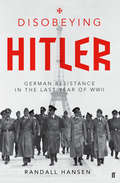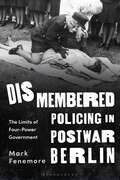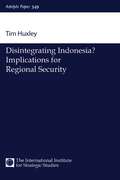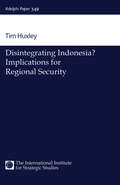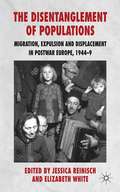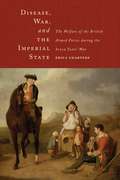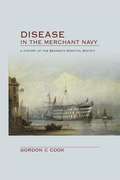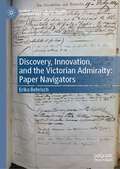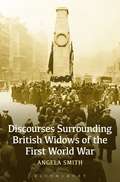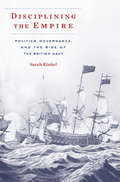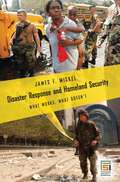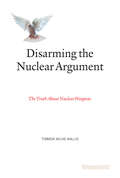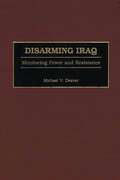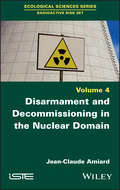- Table View
- List View
Dispatches: Picador Classic (Picador Classic #23)
by Michael HerrWith an introduction by Kevin Powers.A groundbreaking piece of journalism which inspired Stanley Kubrick's classic Vietnam War film Full Metal Jacket.We took space back quickly, expensively, with total panic and close to maximum brutality. Our machine was devastating. And versatile. It could do everything but stop.Michael Herr went to Vietnam as a war correspondent for Esquire. He returned to tell the real story in all its hallucinatory madness and brutality, cutting to the quick of the conflict and its seductive, devastating impact on a generation of young men. His unflinching account is haunting in its violence, but even more so in its honesty. First published in 1977, Dispatches was a revolutionary piece of new journalism that evoked the experiences of soldiers in Vietnam and has forever shaped our understanding of the conflict. It is now a seminal classic of war reportage.
Disobeying Hitler: German Resistance in the Last Year of WWII
by Randall HansenIn the last months of the war, Hitler ordered the poisoning, blocking, and wrecking of all ports across Europe; the destruction of all industries, railroads, bridges, utilities supplies, archives and museums in Europe; and the destruction of the most beautiful city in the world: Paris. Thanks to the determination and bravery of a few, including those who paid with their lives, Hitler's orders were often disobeyed. The result was a profound and lasting effect on the war and its aftermath.In this fascinating and gripping book, Randall Hansen explores the extraordinary phenomenon of disobedience and its consequences: would Rommel have opened the Western Front to the Allies on July 20, 1944 had he not been shot up a few days earlier? Did Albert Speer single-handedly prevent the destruction of bridges, factories, towns,and all features of civilized life? Did the actions of one Prussian General save Paris from total devastation? And why were some German cities defended to the last man, leading to a great loss of life and the cities' complete destruction, while others surrendered without a fight?
Dismembered Policing in Postwar Berlin: The Limits of Four-Power Government
by Mark FenemoreAssessing the impact of Germany's defeat on the policing of Berlin, this book addresses the reconstruction of the police force as a crucial component of four-power government. As Mark Fenemore shows, getting four nationalities to work together to administer a complex major city was a unique undertaking, never before attempted. The situation was made even more difficult by the conditions of hunger and desperation that caused a spike in crime. The stage was a city in ruins, the capital of a defeated, divided, prostrate, occupied country. The audience the administrations were playing to was a population deeply scarred by Nazism, total war, cold, hunger and mass rape.Dismembered Policing explores postwar Berlin from the perspective of all four occupiers and of ordinary Berliners. Fenemore discusses how each occupation government sought to act as an advertisement for its country's respective cultural values, mores and system of governance.As an international, multi-archival study, the book draws on evidence in French and German as well as in English. Using law enforcement as a lens, it examines issues like mass rape, the black market, interracial sex and political violence. With hunger, sexually motivated assault and dismembered body parts featuring prominently, it is reminiscent of Ian McEwen's novel The Innocent, but based on real police files.
Dismembered Policing in Postwar Berlin: The Limits of Four-Power Government
by Mark FenemoreAssessing the impact of Germany's defeat on the policing of Berlin, this book addresses the reconstruction of the police force as a crucial component of four-power government. As Mark Fenemore shows, getting four nationalities to work together to administer a complex major city was a unique undertaking, never before attempted. The situation was made even more difficult by the conditions of hunger and desperation that caused a spike in crime. The stage was a city in ruins, the capital of a defeated, divided, prostrate, occupied country. The audience the administrations were playing to was a population deeply scarred by Nazism, total war, cold, hunger and mass rape.Dismembered Policing explores postwar Berlin from the perspective of all four occupiers and of ordinary Berliners. Fenemore discusses how each occupation government sought to act as an advertisement for its country's respective cultural values, mores and system of governance.As an international, multi-archival study, the book draws on evidence in French and German as well as in English. Using law enforcement as a lens, it examines issues like mass rape, the black market, interracial sex and political violence. With hunger, sexually motivated assault and dismembered body parts featuring prominently, it is reminiscent of Ian McEwen's novel The Innocent, but based on real police files.
Disintegrating Indonesia?: Implications for Regional Security (Adelphi series)
by Tim HuxleySince the collapse of President Suharto's New Order regime in 1998 and the international intervention in East Timor in 1999, there has been much speculation in South-east Asia and the West over whether Indonesia - weakened by economic difficulties, social distresses and political instability - has a future as a coherent nation-state. This paper argues that although the separatist struggles in Aceh or Papua are unlikely to suceed in the foreseeable future, other problems threaten to undermine the central government's control. Communal disputes have led to chronic violence in Maluku, Central Sulawesi, and Kalimantan. Simultaneously, tension between Islamic and secular political forces has grown. Indonesia's disarray has prompted international concern over an array of security threats, including contagious secessionism, Islamic terrorism, the movement through Indonesia of asylum-seekers, piracy and environmental dangers. In order to contain these security implications of Indonesia's protracted crisis, concerned governments should continue assisting its fragile reform process, particularly by helping Jakarta to manage the country's massive international debt. However, they should also coordinate their contingency planning for a further crumbling of Jakarta's authority.
Disintegrating Indonesia?: Implications for Regional Security (Adelphi series #No.349)
by Tim HuxleySince the collapse of President Suharto's New Order regime in 1998 and the international intervention in East Timor in 1999, there has been much speculation in South-east Asia and the West over whether Indonesia - weakened by economic difficulties, social distresses and political instability - has a future as a coherent nation-state. This paper argues that although the separatist struggles in Aceh or Papua are unlikely to suceed in the foreseeable future, other problems threaten to undermine the central government's control. Communal disputes have led to chronic violence in Maluku, Central Sulawesi, and Kalimantan. Simultaneously, tension between Islamic and secular political forces has grown. Indonesia's disarray has prompted international concern over an array of security threats, including contagious secessionism, Islamic terrorism, the movement through Indonesia of asylum-seekers, piracy and environmental dangers. In order to contain these security implications of Indonesia's protracted crisis, concerned governments should continue assisting its fragile reform process, particularly by helping Jakarta to manage the country's massive international debt. However, they should also coordinate their contingency planning for a further crumbling of Jakarta's authority.
Disguise: A Novel
by Hugo HamiltonHugo Hamilton, the internationally acclaimed author of ‘The Speckled People’ and ‘Sailor in the Wardrobe’, turns his hand back to fiction with a compelling drama tracing Berlin's central historical importance throughout the twentieth century.
The Disentanglement of Populations: Migration, Expulsion and Displacement in postwar Europe, 1944-49
by Jessica Reinisch Elizabeth WhiteAn examination of population movements, both forced and voluntary, within the broader context of Europe in the aftermath of the Second World War, in both Western and Eastern Europe. The authors bring to life problems of war and post-war chaos, and assess lasting social, political and demographic consequences.
Disease, War, and the Imperial State: The Welfare of the British Armed Forces during the Seven Years' War
by Erica ChartersThe Seven Years’ War, often called the first global war, spanned North America, the West Indies, Europe, and India. In these locations diseases such as scurvy, smallpox, and yellow fever killed far more than combat did, stretching the resources of European states. In Disease, War, and the Imperial State, Erica Charters demonstrates how disease played a vital role in shaping strategy and campaigning, British state policy, and imperial relations during the Seven Years’ War. Military medicine was a crucial component of the British war effort; it was central to both eighteenth-century scientific innovation and the moral authority of the British state. Looking beyond the traditional focus of the British state as a fiscal war-making machine, Charters uncovers an imperial state conspicuously attending to the welfare of its armed forces, investing in medical research, and responding to local public opinion. Charters shows military medicine to be a credible scientific endeavor that was similarly responsive to local conditions and demands. Disease, War, and the Imperial State is an engaging study of early modern warfare and statecraft, one focused on the endless and laborious task of managing manpower in the face of virulent disease in the field, political opposition at home, and the clamor of public opinion in both Britain and its colonies.
Disease, War, and the Imperial State: The Welfare of the British Armed Forces during the Seven Years' War
by Erica ChartersThe Seven Years’ War, often called the first global war, spanned North America, the West Indies, Europe, and India. In these locations diseases such as scurvy, smallpox, and yellow fever killed far more than combat did, stretching the resources of European states. In Disease, War, and the Imperial State, Erica Charters demonstrates how disease played a vital role in shaping strategy and campaigning, British state policy, and imperial relations during the Seven Years’ War. Military medicine was a crucial component of the British war effort; it was central to both eighteenth-century scientific innovation and the moral authority of the British state. Looking beyond the traditional focus of the British state as a fiscal war-making machine, Charters uncovers an imperial state conspicuously attending to the welfare of its armed forces, investing in medical research, and responding to local public opinion. Charters shows military medicine to be a credible scientific endeavor that was similarly responsive to local conditions and demands. Disease, War, and the Imperial State is an engaging study of early modern warfare and statecraft, one focused on the endless and laborious task of managing manpower in the face of virulent disease in the field, political opposition at home, and the clamor of public opinion in both Britain and its colonies.
Disease, War, and the Imperial State: The Welfare of the British Armed Forces during the Seven Years' War
by Erica ChartersThe Seven Years’ War, often called the first global war, spanned North America, the West Indies, Europe, and India. In these locations diseases such as scurvy, smallpox, and yellow fever killed far more than combat did, stretching the resources of European states. In Disease, War, and the Imperial State, Erica Charters demonstrates how disease played a vital role in shaping strategy and campaigning, British state policy, and imperial relations during the Seven Years’ War. Military medicine was a crucial component of the British war effort; it was central to both eighteenth-century scientific innovation and the moral authority of the British state. Looking beyond the traditional focus of the British state as a fiscal war-making machine, Charters uncovers an imperial state conspicuously attending to the welfare of its armed forces, investing in medical research, and responding to local public opinion. Charters shows military medicine to be a credible scientific endeavor that was similarly responsive to local conditions and demands. Disease, War, and the Imperial State is an engaging study of early modern warfare and statecraft, one focused on the endless and laborious task of managing manpower in the face of virulent disease in the field, political opposition at home, and the clamor of public opinion in both Britain and its colonies.
Disease, War, and the Imperial State: The Welfare of the British Armed Forces during the Seven Years' War
by Erica ChartersThe Seven Years’ War, often called the first global war, spanned North America, the West Indies, Europe, and India. In these locations diseases such as scurvy, smallpox, and yellow fever killed far more than combat did, stretching the resources of European states. In Disease, War, and the Imperial State, Erica Charters demonstrates how disease played a vital role in shaping strategy and campaigning, British state policy, and imperial relations during the Seven Years’ War. Military medicine was a crucial component of the British war effort; it was central to both eighteenth-century scientific innovation and the moral authority of the British state. Looking beyond the traditional focus of the British state as a fiscal war-making machine, Charters uncovers an imperial state conspicuously attending to the welfare of its armed forces, investing in medical research, and responding to local public opinion. Charters shows military medicine to be a credible scientific endeavor that was similarly responsive to local conditions and demands. Disease, War, and the Imperial State is an engaging study of early modern warfare and statecraft, one focused on the endless and laborious task of managing manpower in the face of virulent disease in the field, political opposition at home, and the clamor of public opinion in both Britain and its colonies.
Disease in the Merchant Navy: A History of the Seamen's Hospital Society
by Gordon Cook Anna PavlovIn this unique, highly detailed examination, Gordon C Cook explores disease in the merchant navy through the history of the Seamen's Hospital Society. From its foundation in 1812, until the present day, the Seamen's Hospital Society has been responsible for the physical welfare of merchant seamen and has headed many remarkable advances in medical science. This handsome volume is ideal for all those with an interest in the Seamen's Hospital Society, medical and naval historians, and general readers with an interest in maritime and naval history.
Disease in the Merchant Navy: A History of the Seamen's Hospital Society
by Gordon Cook Anna PavlovIn this unique, highly detailed examination, Gordon C Cook explores disease in the merchant navy through the history of the Seamen's Hospital Society. From its foundation in 1812, until the present day, the Seamen's Hospital Society has been responsible for the physical welfare of merchant seamen and has headed many remarkable advances in medical science. This handsome volume is ideal for all those with an interest in the Seamen's Hospital Society, medical and naval historians, and general readers with an interest in maritime and naval history.
Discovery, Innovation, and the Victorian Admiralty: Paper Navigators (Global Studies in Social and Cultural Maritime History)
by Erika BehrischThis book examines the British Admiralty’s engagement with science and technological innovation in the nineteenth century. It is a book about people, and gross misunderstanding, about the dreams and disappointments of scientific workers and inventors in relation to the administrators who adjudicated their requests for support, and about the power of paper to escalate arguments, reduce opinions, and frustrate hopes. From instructions for naval surveying to debates about rewards to civilians for inventions, Paper Navigators puts a wide range of primary sources in the context of public debates and explores the British Admiralty’s engagement with, decision-making around, and management of questions of value, support, and funding with citizen inventors, the broader public, and their own employees. Concentrating on the Admiralty’s private, internal correspondence to explore these themes, it offers a fresh perspective on the Victorian Navy's history of innovation and exploration and is a novel addition to literature on the history of science in the nineteenth century.
Discourses Surrounding British Widows of the First World War
by Angela SmithUsing extensive data - mostly gleaned from the National Archives - this book examines the way in which British widows of servicemen who died in the First World War were represented in society and by themselves, exploring the intertwining discourses of social welfare, national identity, and morality that can be identified in these texts. Focusing on two widows, the book encourages their individual stories to emerge and gives a voice to an otherwise forgotten group of women whose stories have been lost under the literary tomes of middle-class writers such as Vera Brittain and May Wedderburn Cannon. The discussion is further informed by a wider reading of 300 other such files, which allows wider observations to be made about the nature of the discourses examined, and offers the most complete possible picture for such data. Offering a streamlined adaptation of the Discourse-Historical Approach to critical discourse analysis, Discourses Surrounding British Widows of the First World War demonstrates how this model of analysis can be used to investigate a large body of data from a wide variety of sources, covering a long period of time. As such it will be useful to all scholars in their analysis of historical corpa.
Discourses Surrounding British Widows of the First World War
by Angela SmithUsing extensive data - mostly gleaned from the National Archives - this book examines the way in which British widows of servicemen who died in the First World War were represented in society and by themselves, exploring the intertwining discourses of social welfare, national identity, and morality that can be identified in these texts. Focusing on two widows, the book encourages their individual stories to emerge and gives a voice to an otherwise forgotten group of women whose stories have been lost under the literary tomes of middle-class writers such as Vera Brittain and May Wedderburn Cannon. The discussion is further informed by a wider reading of 300 other such files, which allows wider observations to be made about the nature of the discourses examined, and offers the most complete possible picture for such data. Offering a streamlined adaptation of the Discourse-Historical Approach to critical discourse analysis, Discourses Surrounding British Widows of the First World War demonstrates how this model of analysis can be used to investigate a large body of data from a wide variety of sources, covering a long period of time. As such it will be useful to all scholars in their analysis of historical corpa.
Disciplining the Empire: Politics, Governance, and the Rise of the British Navy (Harvard historical studies ; #v. 189)
by Sarah Kinkel“Rule Britannia! Britannia rule the waves,” goes the popular lyric. The fact that the British built the world’s greatest empire on the basis of sea power has led many to assume that the Royal Navy’s place in British life was unchallenged. Yet, as Sarah Kinkel shows, the Navy was the subject of bitter political debate. The rise of British naval power was neither inevitable nor unquestioned: it was the outcome of fierce battles over the shape of Britain’s empire and the bonds of political authority. Disciplining the Empire explains why the Navy became divisive within Anglo-imperial society even though it was also successful in war. The eighteenth century witnessed the global expansion of British imperial rule, the emergence of new forms of political radicalism, and the fracturing of the British Atlantic in a civil war. The Navy was at the center of these developments. Advocates of a more strictly governed, centralized empire deliberately reshaped the Navy into a disciplined and hierarchical force which they hoped would win battles but also help control imperial populations. When these newly professionalized sea officers were sent to the front lines of trade policing in North America during the 1760s, opponents saw it as an extension of executive power and military authority over civilians—and thus proof of constitutional corruption at home. The Navy was one among many battlefields where eighteenth-century British subjects struggled to reconcile their debates over liberty and anarchy, and determine whether the empire would be ruled from Parliament down or the people up.
Disciplining the Empire: Politics, Governance, and the Rise of the British Navy (Harvard historical studies ; #v. 189)
by Sarah Kinkel“Rule Britannia! Britannia rule the waves,” goes the popular lyric. The fact that the British built the world’s greatest empire on the basis of sea power has led many to assume that the Royal Navy’s place in British life was unchallenged. Yet, as Sarah Kinkel shows, the Navy was the subject of bitter political debate. The rise of British naval power was neither inevitable nor unquestioned: it was the outcome of fierce battles over the shape of Britain’s empire and the bonds of political authority. Disciplining the Empire explains why the Navy became divisive within Anglo-imperial society even though it was also successful in war. The eighteenth century witnessed the global expansion of British imperial rule, the emergence of new forms of political radicalism, and the fracturing of the British Atlantic in a civil war. The Navy was at the center of these developments. Advocates of a more strictly governed, centralized empire deliberately reshaped the Navy into a disciplined and hierarchical force which they hoped would win battles but also help control imperial populations. When these newly professionalized sea officers were sent to the front lines of trade policing in North America during the 1760s, opponents saw it as an extension of executive power and military authority over civilians—and thus proof of constitutional corruption at home. The Navy was one among many battlefields where eighteenth-century British subjects struggled to reconcile their debates over liberty and anarchy, and determine whether the empire would be ruled from Parliament down or the people up.
Disaster Response and Homeland Security: What Works, What Doesn't (Praeger Security International)
by James MiskelHurricane Katrina is the latest in a series of major disasters that were not well managed, but it is not likely to be the last. Category 4 and category 5 hurricanes will, according to most predictions, become both more frequent and more intense in the future due to global warming and/or natural weather cycles. In addition, it is often said that another terrorist attack on the United States is inevitable; that it is a question of when, not whether. Add to that the scare over a possible avian flu pandemic. As a result, the United States should expect that disaster response—to natural and other types of disasters—will continue to be of vital concern to the American public and the policymakers and officials who deal with disaster response and relief, including the military.The U.S. disaster relief program reflects a basic division of responsibility between federal, state, and local governments that has generally stood the test of time. At the federal level, a single agency, FEMA—now under the Department of Homeland Security—has been charged with the responsibility for coordinating the activities of the various federal agencies that have a role in disaster relief. A successful disaster response requires three things: timely and effective coordination between state and federal governments; effective coordination among the federal agencies; and effective coordination between and among state and local government agencies. Miskel, a former Deputy Assistant Associate Director of FEMA, examines the effects that operational failures after Hurricanes Agnes, Hugo, Andrew, and Katrina have had on the organizational design and operating principles of the disaster response system program. He also discusses the impact of 9/11 and the evolving role of the military, and he identifies reforms that should be implemented to improve the nation's ability to respond in the future.
Disarming the Nuclear Argument: The Truth About Nuclear Weapons
by Timmon Milne WallisNuclear weapons are too important to be left to politicians and generals. They need to be discussed in the pub, at the school gates and over the kitchen sink so that people are aware of the issues involved and have had the opportunity to think them through. TIMMON MILNE WALLISHow much do nuclear weapons actually cost? How safe are nuclear weapons, even if they are never used? Have nuclear weapons kept us safe since the end of World War II? Are nuclear weapons legal under International Law?The nine nuclear weapon states are extending their commitments to nuclear 'deterrence' well into the second half of this century, despite treaty obligations and an 'unequivocal undertaking' to disarm. The US alone is expecting to spend up to $1 trillion (ie. $1,000,000,000,000) upgrading its nuclear weapons over the next 30 years.With around 15,000 nuclear weapons stockpiled worldwide, the risk of one going off by accident or design is increasing every day. Timmon Milne Wallis explores the arguments in favour of nuclear weapons with a critical eye, cutting through the rhetoric and obfuscation to get to the real truth about these weapons.
Disarming Iraq: Monitoring Power and Resistance
by Michael V. DeaverThe implementation of disarmament requirements imposed by the Security Council after the Second Gulf War established a strong and unequal power relationship between the United Nations and Iraq. Although the ensuing struggle over imposed disarmament has been a major issue in world politics, international relations theorists continue to ignore it. Deaver argues that this case has important theoretical implications. Using sociological insights and a behavioral approach, he examines the power relationship as well as Iraqi resistance from 1991 to 1998. Theorists are likely to find these analytic tools useful since they provide a ready means of studying the micro-foundations of power relations in generalized terms.Behavior such as supervision, surveillance, inspection, and monitoring are widespread and growing in world politics. A focus on tactics demonstrates the role of monitoring in maintaining and strengthening the relationship between the United Nations and Iraq. An analysis of dynamics makes comprehensible Iraqi losses of sovereignty and the eventual collapse of the relationship. Contrary to popular opinion, whoever escalated tensions hurt their own cause: Iraqi resistance contributed greatly to United Nations gains, while the United Nations successes led to the collapse of its relationship with Iraq.
Disarmament and Decommissioning in the Nuclear Domain
by Jean-Claude AmiardFollowing the acquisition of the atomic bomb by five states, the United Nations began drafting several treaties to limit nuclear proliferation. These efforts failed, as four more states also acquired nuclear weapons. In a similar vein, an attempt to limit atomic weapons - primarily within the two superpowers - was initiated.While the number of weapons has decreased, the new bombs now being manufactured are more powerful and more precise, negating any reduction in numbers. In the field of civil nuclear use, all nuclear facilities (reactors, factories, etc.) have a limited lifespan. Once a plant is permanently shut down, these facilities must be decommissioned and dismantled.These operations are difficult, time-consuming and costly. In addition, decommissioning generates large volumes of radioactive waste of various categories, including long-lived and high-activity waste. Risks to the environment and to health are not negligible during decommissioning. The International Atomic Energy Agency (IAEA) and the Nuclear Energy Agency (NEA) of the Organisation for Economic Co-operation and Development (OECD) have produced numerous publications with recommendations. Each state has its own decommissioning strategy (immediate or delayed) and final plan for the site - whether it be returning it to greenfield status or obtaining a nuclear site license with centuries-long monitoring.
Disarmament and Decommissioning in the Nuclear Domain
by Jean-Claude AmiardFollowing the acquisition of the atomic bomb by five states, the United Nations began drafting several treaties to limit nuclear proliferation. These efforts failed, as four more states also acquired nuclear weapons. In a similar vein, an attempt to limit atomic weapons - primarily within the two superpowers - was initiated.While the number of weapons has decreased, the new bombs now being manufactured are more powerful and more precise, negating any reduction in numbers. In the field of civil nuclear use, all nuclear facilities (reactors, factories, etc.) have a limited lifespan. Once a plant is permanently shut down, these facilities must be decommissioned and dismantled.These operations are difficult, time-consuming and costly. In addition, decommissioning generates large volumes of radioactive waste of various categories, including long-lived and high-activity waste. Risks to the environment and to health are not negligible during decommissioning. The International Atomic Energy Agency (IAEA) and the Nuclear Energy Agency (NEA) of the Organisation for Economic Co-operation and Development (OECD) have produced numerous publications with recommendations. Each state has its own decommissioning strategy (immediate or delayed) and final plan for the site - whether it be returning it to greenfield status or obtaining a nuclear site license with centuries-long monitoring.
The Disappearance of Astrid Bricard: a captivating story of love, betrayal and passion from the author of The Paris Secret
by Natasha Lester'Vogue meets Daisy Jones & The Six . . . Natasha Lester's most compelling novel yet!' - Kate Quinn, author of, The Rose Code'Brave, bold, and beautiful . . . I couldn't stop reading' - Kerri Maher, author of, The Paris Bookseller'Natasha Lester at her best!' - Chanel Cleeton, author of, Next Year in HavanaIn November 1973, a legend vanished, leaving behind only a white silk dress and the question: what happened to Astrid Bricard?1917. Parentless, sixteen-year-old Mizza Bricard, at a party surrounded by the most scandalous women in Paris - including Coco Chanel - sees what society expects of a woman alone in the world. That night, she vows to never be gossiped about because of who has paid for her pearls, a vow that drives her through decades and couture houses until finally her name is remembered and a legend created.1970. Astrid Bricard arrives in New York determined to change the fashion world forever. But when she meets fellow designer Hawk Jones and they embark on a passionate love affair, she finds herself cast in the role of muse, her own talent ignored. Then comes the Battle of Versailles, a competition between American and French designers which marks the making of Hawk's career, and the end of Astrid Brichard.Present Day. Blythe Bricard is determined not to be anyone's muse - even if that means turning her back on her own designing dreams. Until she's invited to a French chateau where, upon arrival, she discovers that there may be more to her mother and grandmother's stories than she'd thought...Set in the opulent world of luxury fashion, The Disappearance of Astrid Bricard is a heart-wrenching story of love, courage and betrayal, from the internationally bestselling author of The Paris Secret. Perfect for fans of The Seven Husbands of Evelyn Hugo, Rachel Hore and Lucinda Riley.

